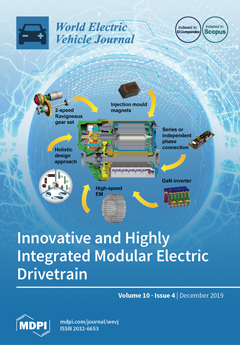Open AccessArticle
Innovative and Highly Integrated Modular Electric Drivetrain
by
Jonas Hemsen, Daniel Kieninger, Lutz Eckstein, Mathias R. Lidberg, Henk Huisman, Juris Arrozy, Elena A. Lomonova, Daniel Oeschger, Charley Lanneluc, Olivier Tosoni, Patrick Debal, Michael Ernstorfer and Rémi Mongellaz
Cited by 7 | Viewed by 5766
Abstract
A highly integrated electric drivetrain module with 157 kW peak power is presented, which incorporates novel technologies in the field of electric machines, power electronics and transmissions: 1. High-speed electric machine with six phases and injection mould polymer-bonded magnets; 2. High-ratio dual-speed transmission
[...] Read more.
A highly integrated electric drivetrain module with 157 kW peak power is presented, which incorporates novel technologies in the field of electric machines, power electronics and transmissions: 1. High-speed electric machine with six phases and injection mould polymer-bonded magnets; 2. High-ratio dual-speed transmission with double planetary gear set (Ravigneaux gear set); 3. Gallium nitride (GaN) power electronics with winding reconfiguration feature.The combination of these components in one single housing makes the drive module flexible to integrate and to combine with conventional or alternative propulsion technologies, thus allowing various hybrid and electric drivetrain topologies. All technologies are selected in accordance with mass production potential and can therefore have a high impact on the automotive market in the future. Currently, the drive module is under development; the first models will be assembled in winter 2019. The integration into a demonstrator vehicle in 2020 will prove the potential of many new technologies and the suitability for the automotive market.
Full article
►▼
Show Figures





